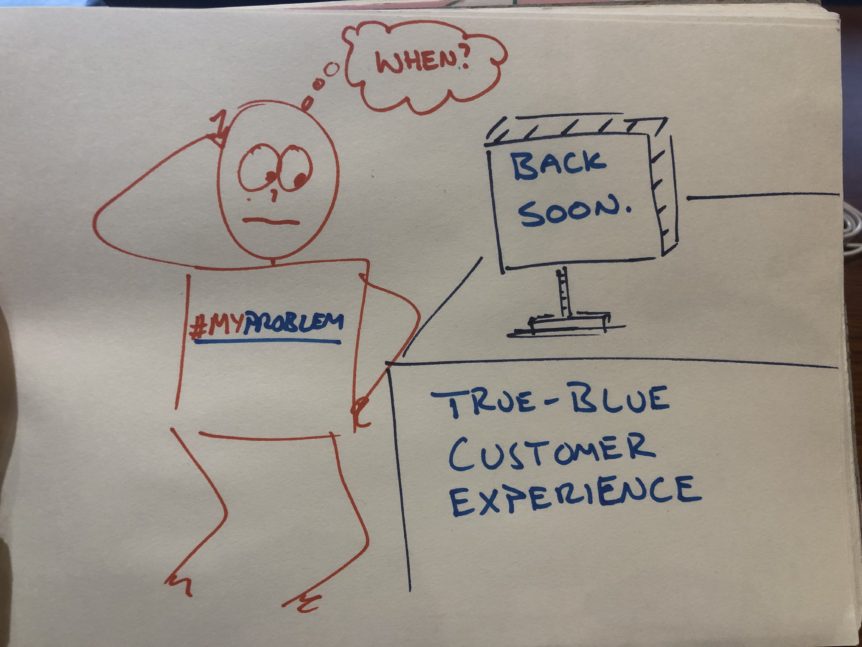While my tone in the last article may have made me sound pessimistic, I can assure you I’m not. In fact, my position is the exact opposite. There is a huge opportunity here in Australia for the right organisation. Remember, more than 85 percent of businesses in this country are classified as service entities—and I would wager that the majority of those have shockingly poor customer experience.
While attitudes towards customer experience in the majority of organisations around the country are textbook fails, this is not a bad thing. It means that if you happen to be one of the leaders who gets it, and you can manage to design even a decent customer experience and get your people to walk the talk, then you’re laughing. Because your next closest competitor probably isn’t on this continent. Truly.
Why? Because good customer experience in Australia is, well, so un-Australian. When we finally experience it, it’s remarkable and worth talking about.
Let me give you an example. Without even thinking about it, I can tell you right now about my best customer experience in the last ten years. And it’s not that it was the best among dozens of positive experiences. What I mean is, in the last ten years, this is far and away one of the only noteworthy customer experiences I’ve had. This was not me searching for the holy grail of customer satisfaction, this was simply me going through my day as a typical Aussie and thinking about when a situation didn’t become “my problem.”
I’ll mention at the outset that this is a business-to-customer experience. Even if I wanted to give you a business-to-business example from one of my clients, I couldn’t do it. I mean, I literally haven’t come across a situation worth talking about—in a positive light, that is.
Anyway, on with the story. This happened about seven years ago. I was living in Sydney at the time, and I was working as an innovation consultant. As an innovation consultant, I spent most of my time experiencing business problems firsthand and then helping clients to create new exciting product designs to solve those problems.
At that time, the whiteboard I had in my office was fairly small and not in the best shape because it had been left there by the previous tenant, who most certainly did not adhere to the sacred whiteboard owners’ oath to never use scratch pads to clean the surface of your board.
Like most whiteboard enthusiasts, I needed to increase my writing surface because I intuitively believed that the greater the surface area, the greater the volume of ideas (now I’m older and know the difference between rational and intuitive decision-making.) We weren’t going wall-to-wall back then, so an overpriced oversized whiteboard was the way to go. I set out on the weekend hoping to pop into the store, find the right whiteboard, and then get back to the office and install it so we’d be all set for Monday morning.
I walked into the store around midday and approached one of the clerks, who was down on his hands and knees doing some restocking or pricing or something. I asked where the whiteboards were.
To my surprise, he stood up and looked me straight in the eye.
I know. I know what you’re probably thinking: impossible. But no, it happened.
The eye contact and the fact that he stood up immediately took me by surprise. But what happened next almost knocked me to the floor. Rather than looking confused, mumbling something about which aisle contained the whiteboards, or just giving me the ol’ autopiloted wave towards the rear of the store, he smiled at me, stopped what he was doing, and said, “No worries, I’ll walk you over.” And he did. And I followed.
After I made my selection, which as you would expect, must have been the largest whiteboard on the market, I walked up to the front of the store to get some help carrying it out. Lo and behold, the same service clerk saw me and walked over to ask if I found the one I was looking for.
Here comes the knockout punch: he stopped what he was doing again, grabbed a trolley and loaded the whiteboard up, wheeled it to the front of the store, opened up another register so I didn’t have to wait in line, then walked the whiteboard outside to my car and helped me load it.
After we loaded it, I told him that this was the most insane customer service experience I’d ever had in Australia. I tried to put $20 in his hand to give him a tip. He refused, smiled, and said, “Hey, that’s what we’re here for.”
Well done, Officeworks!
There’s only one problem. That never happened to me again. Not at that location or any other location I’ve visited since.
In statistical process control, we map out something called the voice of the process using a process behaviour chart (control chart). That little outlier, that little astronomical data point which was my experience, was nothing more than a black swan. You see, it’s not part of the normal process.
But imagine if it was. Imagine if that was your company.
I wonder if an organisation’s bottom line would improve if their business could turn that corner. Where their employees embodied that customer-first mentality, their processes behaved the way they wanted them to, and the experience one had as a customer accurately reflected the passion of the leadership team. Where, instead of a business luckboxing into a one-off, above-average customer experience, it was simply business as usual.
I’ll tell you what would likely happen: it would have virtually no competition in the Australian market. Because most Australian companies get this wrong just about every single time.
Does this mean that Australians aren’t friendly? No, not at all. Many Aussies are very friendly and very helpful. And sometimes when you deal with people, they will go out of their way to help you. But it’s almost always the person doing it of their own accord, not as a result of the process they’re following. Which is why the experience varies from location to location or person to person.
If it hasn’t detonated in your mind already, here is my point: If you can design a pleasant experience with enough consistency that your products, services, or processes achieve a basic level of repeatability and reproducibility, and you’ve satisfied the “must-haves” and a handful of the “nice-to-haves”—the result to your competition can be summed up in one word: pwned.
Until Next Time—

Mike is the Founder and General Manager of Redshift Consulting, Founder of Praetorian Code, and Board Member to the International Business TRIZ Association. He holds a Masters in Innovation and Entrepreneurship (UMD) and a Bachelors in Psychology and Education (UCSB). He is a Certified Lean Six Sigma Black Belt (UTS); Certified Practitioner of Theory of Inventive Problem Solving (TRIZ); former US Army Ranger and a Brazilian Jiu-Jitsu fanatic.

